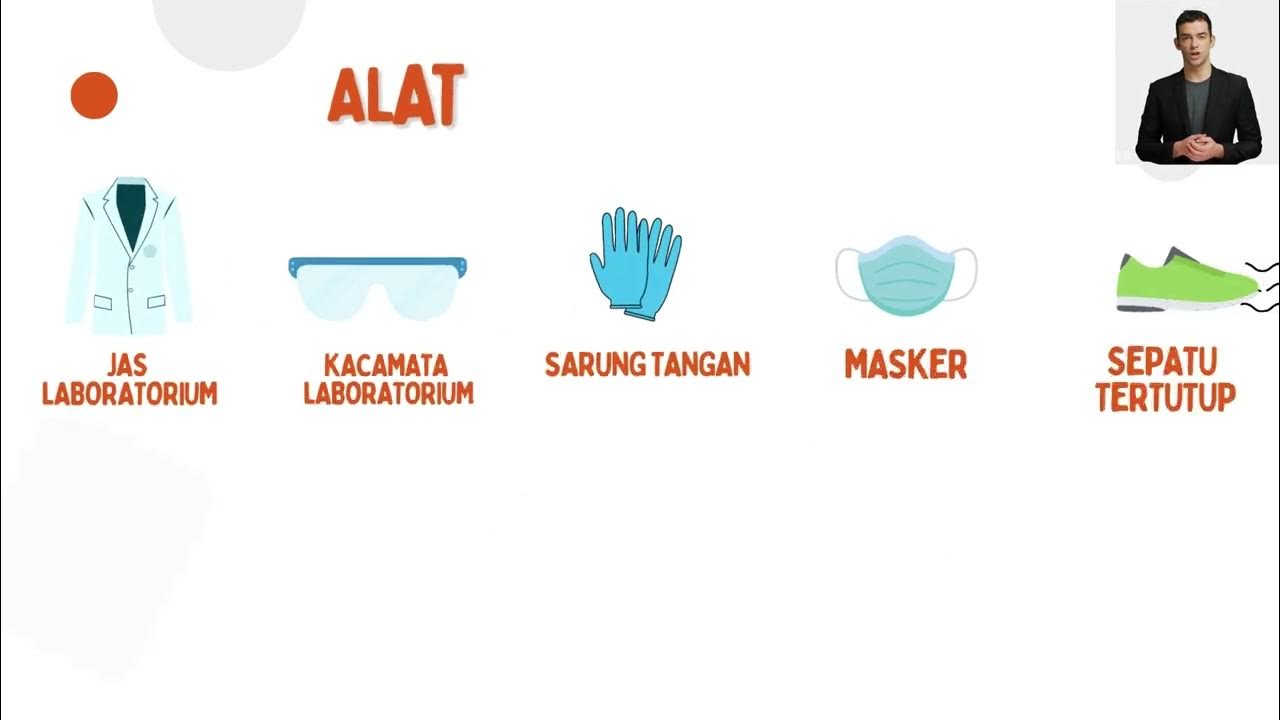Laboratory Safety-General Safety
Summary
TLDRThis video outlines essential lab safety rules for handling chemicals and biological materials. Key guidelines include the prohibition of food and drink, securing long hair, wearing a lab coat, and using close-toed shoes to prevent accidents. Proper hand protection with gloves and eye protection with goggles are emphasized, along with maintaining a clean workspace using disinfectants like isopropanol and bleach. The video also highlights the importance of washing hands before and after lab work to ensure safety and prevent contamination. These steps are crucial to safeguard personal health and the integrity of experiments.
Takeaways
- 😀 No food or drink allowed in the lab to avoid contamination and potential health risks from hazardous chemicals.
- 😀 Secure long hair with a pin or hat to prevent it from being exposed or catching on fire during lab work.
- 😀 Always wear a lab coat, ensuring it is fully buttoned to protect your clothing and body from chemicals and accidents.
- 😀 Wear close-toed shoes to protect your feet from potential accidents like glass breakage or chemical spills.
- 😀 Keep personal items, such as your book bag, off the lab table and store them safely underneath the workbench.
- 😀 Wear gloves to protect your hands when handling chemicals or biological materials like blood or cells.
- 😀 Use appropriate eye protection, such as goggles or eyewear, to shield your eyes from chemical splashes and flames.
- 😀 Maintain a clean and organized work area by using cleaning agents like 70% isopropanol or 10% bleach before and after working in the lab.
- 😀 Always wash your hands thoroughly before and after completing any lab exercises to minimize the risk of contamination.
- 😀 Stay mindful of the risks associated with chemicals and biological materials to protect both yourself and others in the lab.
Q & A
Why is food and drink not allowed in the lab?
-Food and drink are not allowed in the lab to prevent contamination. If you're working with dangerous chemicals, such as those that may cause cancer, consuming food or drink in the lab could increase the risk of exposure.
What should individuals with long hair do before entering the lab?
-Individuals with long hair should securely pin it up or wear a hat to keep it in place. This helps prevent the hair from being exposed or caught in flames in the case of a fire.
Why is it important to wear a lab coat in the laboratory?
-A lab coat provides protection from chemicals and other hazards in the lab. It ensures that your clothing is secure and offers a layer of defense against potential spills or accidents.
What type of shoes should be worn in the lab?
-Close-toed shoes are required in the lab. Sneakers or any other type of closed footwear are acceptable to prevent injury in case of glass or chemical spills.
Where should a book bag be placed in the lab?
-A book bag should not be left on the lab table. It should be placed underneath the workbench area to ensure a clean and safe workspace.
What is the importance of wearing gloves in the lab?
-Gloves protect your hands when handling chemicals, biological materials, or any other potentially harmful substances in the lab. They prevent direct contact with dangerous materials and reduce the risk of contamination.
Why is eye protection necessary in the laboratory?
-Eye protection is essential in the lab to shield your eyes from hazardous chemicals, flying debris, or accidental splashes. Goggles or safety glasses provide this protection.
What are two common types of eye protection used in the lab?
-The two common types of eye protection used in the lab are goggles and safety glasses (eyewear). Both offer protection against potential hazards to the eyes.
What should be done to maintain a clean and safe work area in the lab?
-To maintain a clean work area, you should clean the surface before and after lab activities using agents like 70% isopropanol or 10% bleach. This helps prevent contamination and ensures a safer working environment.
Why is hand washing important in the laboratory?
-Hand washing before and after lab activities is crucial for personal hygiene and safety. It helps remove any potential contaminants from your hands, protecting you from exposure to harmful substances.
Outlines

Dieser Bereich ist nur für Premium-Benutzer verfügbar. Bitte führen Sie ein Upgrade durch, um auf diesen Abschnitt zuzugreifen.
Upgrade durchführenMindmap

Dieser Bereich ist nur für Premium-Benutzer verfügbar. Bitte führen Sie ein Upgrade durch, um auf diesen Abschnitt zuzugreifen.
Upgrade durchführenKeywords

Dieser Bereich ist nur für Premium-Benutzer verfügbar. Bitte führen Sie ein Upgrade durch, um auf diesen Abschnitt zuzugreifen.
Upgrade durchführenHighlights

Dieser Bereich ist nur für Premium-Benutzer verfügbar. Bitte führen Sie ein Upgrade durch, um auf diesen Abschnitt zuzugreifen.
Upgrade durchführenTranscripts

Dieser Bereich ist nur für Premium-Benutzer verfügbar. Bitte führen Sie ein Upgrade durch, um auf diesen Abschnitt zuzugreifen.
Upgrade durchführen5.0 / 5 (0 votes)






